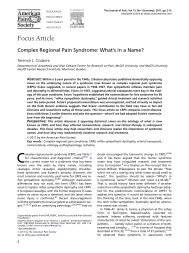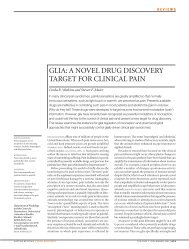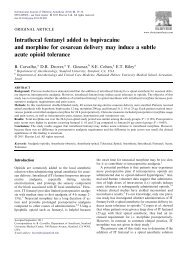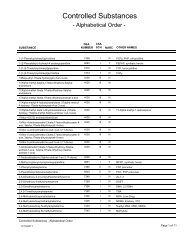1) Vitamin D For Chronic Pain - Pain Treatment Topics.org
1) Vitamin D For Chronic Pain - Pain Treatment Topics.org
1) Vitamin D For Chronic Pain - Pain Treatment Topics.org
Create successful ePaper yourself
Turn your PDF publications into a flip-book with our unique Google optimized e-Paper software.
<strong>Vitamin</strong> D for <strong>Chronic</strong> <strong>Pain</strong><br />
It must be emphasized that vitamin D is not<br />
a pharmaceutical analgesic in the sense of<br />
fostering relatively immediate pain relief, and<br />
expectations along those lines would be unrealistic.<br />
Because <strong>Vitamin</strong> D supplementation<br />
addresses underlying processes, it may take<br />
months to facilitate pain relief, which can range<br />
from partial to complete. Furthermore, vitamin<br />
D supplementation is not proposed as a panacea<br />
or as a replacement for other pain treatment<br />
modalities that may benefit patient care.<br />
<strong>Vitamin</strong> D and ‘D-ficiency’<br />
Pharmacology. <strong>Vitamin</strong> D comprises a group of<br />
fat-soluble micronutrients with two major forms:<br />
D 2 (ergocalciferol) and D 3 (cholecalciferol) 10,11<br />
(see Figure 1). <strong>Vitamin</strong> D 3 is synthesized in the<br />
skin via exposure of endogenous 7-dehydrocholesterol<br />
to direct ultraviolet B (UVB) radiation<br />
in sunlight and is also obtained to a small extent<br />
in the diet (see Table 1). In many countries, some<br />
foods are fortified with vitamin D 3 , which is the<br />
form used in most nutritional supplements. 14,20<br />
<strong>Vitamin</strong> D 2 , on the other hand, is found in<br />
relatively few foods or supplements. 14<br />
Following vitamin D synthesis in the skin or<br />
other intake, some of it is stored in adipose<br />
tissue, skeletal muscle, and many <strong>org</strong>ans, 19 while<br />
a relatively small portion undergoes a two-stage<br />
process of metabolism (see Figure 1). First, D 2<br />
and/or D 3 are metabolized via hydroxylation in<br />
the liver to form 25-hydroxyvitamin D, abbreviated<br />
as 25(OH)D (also called calcidiol). 10,14,18,21,22<br />
This has minimal biological activity and serum<br />
concentrations of 25(OH)D accumulate gradually,<br />
plateauing at steady-state levels by about 40<br />
days 19,23,24 to 90 days. 25,26<br />
The 25(OH)D metabolite is converted primarily<br />
in the kidneys via further hydroxylation to<br />
1,25-dihydroxyvitamin D, abbreviated as<br />
1,25(OH) 2 D (also called calcitriol). It is the most<br />
important and biologically-active vitamin D<br />
metabolite with a short half-life of only 4 to 6<br />
hours 27 but can remain active for 3 to 5 days. 15,20<br />
A central role of vitamin D—via its active<br />
1,25(OH) 2 D metabolite—is to facilitate the<br />
absorption of calcium from the intestine and<br />
help maintain normal concentrations of this<br />
vital agent. Equally important, 1,25(OH) 2 D<br />
sustains a wide range of metabolic and physiologic<br />
functions throughout the body. 28<br />
<strong>Vitamin</strong> D actually is misclassified as a<br />
vitamin; it may be more appropriately considered<br />
a prohormone and its active 1,25(OH) 2 D<br />
metabolite—with its own receptors found in<br />
practically every human tissue—functions as a<br />
hormone. These vitamin D receptors, or VDRs,<br />
may affect the function of up to 1000 different<br />
genes 18,22,29,30,31 helping to control cell growth or<br />
differentiation. The VDRs themselves can differ<br />
Source<br />
TABLE 1: Sources of <strong>Vitamin</strong> D<br />
<strong>Vitamin</strong> D 2 and D 3 Sources<br />
<strong>Vitamin</strong> D Content<br />
Higher-Yield Natural Sources<br />
Exposure to sunlight, ultraviolet B radiation<br />
(0.5 minimal erythemal dose) † 3000–10,000 IU D 3<br />
Salmon fresh, wild (3.5 oz*) 600–1000 IU D 3<br />
Salmon fresh, farmed (3.5 oz) 100–250 IU D 3<br />
Salmon canned (3.5 oz) 300–600 IU D 3<br />
Herring, pickled (3.5 oz) 680 IU D 3<br />
Catfish, poached (3.5 oz) 500 IU D 3<br />
Sardines, canned (3.5 oz) 200–360 IU D 3<br />
Mackerel, canned (3.5 oz) 200–450 IU D 3<br />
Tuna, canned (3.6 oz) 200–360 IU D 3<br />
Cod liver oil (1 tsp / 0.17 oz) 400–1400 IU D 3<br />
Eastern oysters, steamed (3.5 oz) 642 IU D 3<br />
Shiitake mushrooms fresh (3.5 oz) 100 IU D 2<br />
Shiitake mushrooms sun-dried (3.5 oz) 1600 IU D 2<br />
Egg yolk, fresh 20–148 IU D 3<br />
<strong>For</strong>tified Foods<br />
<strong>For</strong>tified milk 60–100 IU/8 oz, usually D 3<br />
<strong>For</strong>tified orange juice 60–100 IU/8 oz usually D 3<br />
Infant formulas 60–100 IU/8 oz usually D 3<br />
<strong>For</strong>tified yogurts 100 IU/8 oz, usually D 3<br />
<strong>For</strong>tified butter 50 IU/3.5 oz, usually D 3<br />
<strong>For</strong>tified margarine 430 IU/3.5 oz, usually D 3<br />
<strong>For</strong>tified cheeses 100 IU/3 oz, usually D 3<br />
<strong>For</strong>tified breakfast cereals 60-100 IU/serving, usually D 3<br />
Food labels often express vitamin D content only as % of daily value, so it is usually<br />
unknown what the exact amount is in International Units (IU).<br />
Supplements<br />
Over The Counter/Internet<br />
‡<br />
Multivitamin (including vitamin D) 400–800 IU vitamin D 2 or D 3<br />
<strong>Vitamin</strong> D (tablets, capsules)<br />
Various doses 400–50,000 IU<br />
(primarily D 3 )<br />
Prescription/Pharmaceutical<br />
<strong>Vitamin</strong> D 2 (ergocalciferol)<br />
50,000 IU/capsule<br />
Drisdol ® , Calciferol ® , others(vitamin D 2 )<br />
liquid supplements<br />
8000 IU/mL<br />
Rocaltrol ® , Calcigex ® , others (1,25[OH] 2 D)<br />
available outside US<br />
0.25-0.5 mcg capsules<br />
1 mcg/mL solution<br />
* 1 oz = 28.3 grams = 29.6 mL; 1 IU = 40 mcg (microgram)<br />
† A 0.5 minimal erythemal dose of UVB radiation would be absorbed after about 10-15 minutes<br />
of exposure of arms and legs to direct sunlight (depending on time of day, season, latitude,<br />
and skin sensitivity). Dark-skinned persons would require longer.<br />
‡ Ergocalciferol on product label signifies D 2 ; cholecalciferol signifies D 3 .<br />
References: Calcitriol 12 ; Ergocalciferol 13 ; Holick 14 ; Marcus 15 ; ODS 16 ; Singh 17 ; Tavera-Mendoza<br />
and White 18 ; and Vieth 19 25<br />
Practical PAIN MANAGEMENT, July/August 2008<br />
©2008 PPM Communications, Inc. Reprinted with permission.













